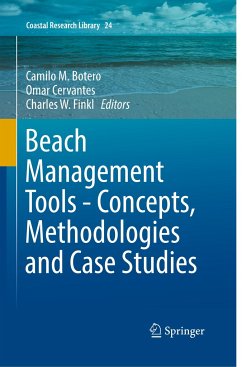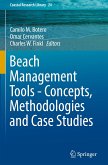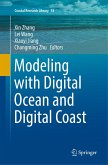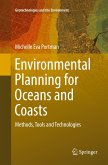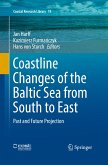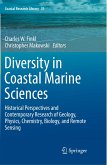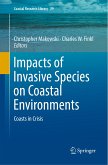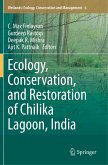Beach Management Tools - Concepts, Methodologies and Case Studies
Herausgegeben:Botero, Camilo M.; Cervantes, Omar; Finkl, Charles W.
Beach Management Tools - Concepts, Methodologies and Case Studies
Herausgegeben:Botero, Camilo M.; Cervantes, Omar; Finkl, Charles W.
- Broschiertes Buch
- Merkliste
- Auf die Merkliste
- Bewerten Bewerten
- Teilen
- Produkt teilen
- Produkterinnerung
- Produkterinnerung
This book provides an overview of beach management tools, including carrying capacity, beach nourishment, environmental and tourism awards (like Blue Flag or others), bathing water quality, zoning, beach typologies, quality index, user's perception, interdisciplinary beach monitoring, coastal legislation, shore protection, social and economic indicators, ecosystem services, and coastal governance (applied in beach case studies). Beaches are one of the most intensely used coastal ecosystems and are responsible for more than half of all global tourism revenues, and as such the book introduces a…mehr
Andere Kunden interessierten sich auch für
![Beach Management Tools - Concepts, Methodologies and Case Studies Beach Management Tools - Concepts, Methodologies and Case Studies]() Beach Management Tools - Concepts, Methodologies and Case Studies234,99 €
Beach Management Tools - Concepts, Methodologies and Case Studies234,99 €![Modeling with Digital Ocean and Digital Coast Modeling with Digital Ocean and Digital Coast]() Modeling with Digital Ocean and Digital Coast81,99 €
Modeling with Digital Ocean and Digital Coast81,99 €![Environmental Planning for Oceans and Coasts Environmental Planning for Oceans and Coasts]() Michael E. PortmanEnvironmental Planning for Oceans and Coasts113,99 €
Michael E. PortmanEnvironmental Planning for Oceans and Coasts113,99 €![Coastline Changes of the Baltic Sea from South to East Coastline Changes of the Baltic Sea from South to East]() Coastline Changes of the Baltic Sea from South to East81,99 €
Coastline Changes of the Baltic Sea from South to East81,99 €![Diversity in Coastal Marine Sciences Diversity in Coastal Marine Sciences]() Diversity in Coastal Marine Sciences146,99 €
Diversity in Coastal Marine Sciences146,99 €![Impacts of Invasive Species on Coastal Environments Impacts of Invasive Species on Coastal Environments]() Impacts of Invasive Species on Coastal Environments113,99 €
Impacts of Invasive Species on Coastal Environments113,99 €![Ecology, Conservation, and Restoration of Chilika Lagoon, India Ecology, Conservation, and Restoration of Chilika Lagoon, India]() Ecology, Conservation, and Restoration of Chilika Lagoon, India113,99 €
Ecology, Conservation, and Restoration of Chilika Lagoon, India113,99 €-
-
-
This book provides an overview of beach management tools, including carrying capacity, beach nourishment, environmental and tourism awards (like Blue Flag or others), bathing water quality, zoning, beach typologies, quality index, user's perception, interdisciplinary beach monitoring, coastal legislation, shore protection, social and economic indicators, ecosystem services, and coastal governance (applied in beach case studies).
Beaches are one of the most intensely used coastal ecosystems and are responsible for more than half of all global tourism revenues, and as such the book introduces a wide range of state-of-the-art tools that can be used to deal with a variety of beach challenges. Each chapter features specific types of tools that can be applied to advantage in beach management practices. With examples of local and regional case studies from around the globe, this is a valuable resource for anyone involved in beach management.
Beaches are one of the most intensely used coastal ecosystems and are responsible for more than half of all global tourism revenues, and as such the book introduces a wide range of state-of-the-art tools that can be used to deal with a variety of beach challenges. Each chapter features specific types of tools that can be applied to advantage in beach management practices. With examples of local and regional case studies from around the globe, this is a valuable resource for anyone involved in beach management.
Produktdetails
- Produktdetails
- Coastal Research Library 24
- Verlag: Springer / Springer International Publishing / Springer, Berlin
- Artikelnr. des Verlages: 978-3-319-86371-9
- Softcover reprint of the original 1st ed. 2018
- Seitenzahl: 984
- Erscheinungstermin: 11. September 2018
- Englisch
- Abmessung: 235mm x 155mm x 49mm
- Gewicht: 1636g
- ISBN-13: 9783319863719
- ISBN-10: 3319863711
- Artikelnr.: 55127717
- Herstellerkennzeichnung
- Books on Demand GmbH
- In de Tarpen 42
- 22848 Norderstedt
- info@bod.de
- 040 53433511
- Coastal Research Library 24
- Verlag: Springer / Springer International Publishing / Springer, Berlin
- Artikelnr. des Verlages: 978-3-319-86371-9
- Softcover reprint of the original 1st ed. 2018
- Seitenzahl: 984
- Erscheinungstermin: 11. September 2018
- Englisch
- Abmessung: 235mm x 155mm x 49mm
- Gewicht: 1636g
- ISBN-13: 9783319863719
- ISBN-10: 3319863711
- Artikelnr.: 55127717
- Herstellerkennzeichnung
- Books on Demand GmbH
- In de Tarpen 42
- 22848 Norderstedt
- info@bod.de
- 040 53433511
Camilo-Mateo Botero SaltarenExpert in integrated coastal management and tourist beaches. European PhD in Water and Coastal Management (Spain), European Master in Water and Coastal Management (Portugal), Master in Ports and Coastal Engineering (Spain), postgraduate course in Public Management (Colombia), UNESCO expert in Tsunami Warning Systems (Hawaii, EEUU), PNUD expert in Multilateral Environmental Agreements (Grenada) European Expert in Marine Spatial Planning (France) and Environmental and Sanitary Engineer (Colombia). He has been professor in Colombia, Ecuador, Cuba, Argentina, Brasil, Puerto Rico and Uruguay in topics such as beach management, environmental impact assessment, coastal management, environmental management and research methods. He is researcher in marine topics since 1996, focusing last years in beach certification schemes and beach environmental quality. He become to several academic networks, such as the Beach Management and Certification IberoamericanNetwork - PROPLAYAS and the Integrated Coastal Management Iberoamerican Network - IBERMAR. Moreover, he is director of the Coastal Systems Research Group in Colombia, researcher in Universidad de La Costa (Colombia), member of editorial board of 'Revista COSTAS' of UNESCO and reviewer of the Ocean and Coastal Management Journal (Elsevier). Author of more than 50 publications, including books, scientific articles and dissemination. Lecturer in over 60 opportunities and advisory over 20 undergraduate and master's thesis. He is fluent in English language and communication skills in Italian and Portuguese. Omar Darío Cervantes RosasDr. Omar Cervantes is specialist in Coastal Zone and Beach Management. He has a master and a PhD in Coastal Oceanography and postgraduate courses in The professionalization of NGOs. Member of national system of researchers en Mexico since 2013. He participated in two short stays in Ceará and Para Brazilian Federal Universities in beach management topics. He is a technical expert in Beach certification and Ecoturism standards of The Mexican Accreditation Body (EMA). He worked to environmental consulting companies (2002-2011) as the project manager of environmental baseline studies in tourism coastal projects, in restoration of coastal environments and environmental supervision. He is a research professor in a Bachelor career of Marine Sciences (Oceanology) and in the Master program of Marine Sciences of the Faculty of Marine Sciences (University of Colima, México). He teaches lectures on Integrated Coastal Zone Management (ICZM), Coastal Ecology, Marine Pollution, Environmental Economics, Risk Management, Coastal Policy Analysis and others topics. He has been instructor in short courses about Beach Management in Brazil, Colombia and Uruguay. Since 2001 he has been an environmental consultant on topics such as Environmental Impact and Environmental Site assessment, focusing his last projects in beachmanagement topics; rip currents and beach risks, environmental valuation, zonification and certification or ecolabels. He published articles at Ocean and Coastal Management, Journal of Coastal Research and Environmental Management Journals. Advisory in undergraduate, masters and PhD¿s thesis. He have communication skills in English and Portuguese language. He has been reviewer of scientific projects for the Council on Science and Technology of Uruguay and México. Now he is a member of scientific networks such as Iberoamerican network of Beach management Proplayas and Integrated Coastal Management (IBERMAR).
1. A Decision Making (DEMA) tool to be used in Ecosystem-Based Management System (EBMS) applications.- 2. Active management of microbiological pollution risks in bathing waters: tools and future perspective.- 3. Affectation of harmful algal blooms in the environment, public health and the development of productive activities in the coastal zone of Mexico: case study of the lack of governance for the solution of this problem.- 4. An overview of Integrated and interdisciplinary approaches to Beach and Coastal.- 5. Analysis of Blue Flag Beaches compared with Natural Beaches in the Balearic Islands and Canary Islands, Spain.- 6. Assessing hotspots to storm-induced hazards in the Catalan coast. Where are my sensitive areas?.- 7. Assessing shoreline change rates in Mediterranean beaches. A comprehensive comparison between datum-based and proxy-based shoreline extraction approaches.- 8. Assessment of beach sand and its associated health effects: an example from port dickson beaches (Malaysia).- 9. Assessment of the Beaches of the Dominican Republic by useful Management Variables.- 10. Beach carrying capacity estimations using HR satellite imagery - a tool to define beach use areas.- 11. Beach Carrying Capacity: The importance of a concept poorly understood.- 12. Beach Ecosystem-based Adaptation.- 13. Beach litter characteristics along the Gibraltar Strait: implications for coastal zone management.- 14. Beach safety management.- 15. Beaches of the southern baltic sea.- 16. Coastal sand dune dynamic and evolutive trend in a headland bay beach system in semi arid Chile: The case of Punta de Choros, Coquimbo.- 17. Comparative Analysis of the Management Process and Governance of beaches between Brazil and Uruguay.- 18. Counting beach visitors: Tools, methods and management applications.- 19. Coupled Human-Nature Tools for Beach Management.- 20. Drowning risk perception in coastal areas: Elements for building a methodology for prevention.- 21. Ecosystem management tools tostudy natural habitats as wave energy dissipation structures and coastal protection mechanisms.- 22. Environmental and health risk by the presence of parasites in the sand of cartagena beaches.- 23. Florida and US East Coast Beach Change Metrics Derived from LiDAR Data Utilizing ArcGIS Python Based Tools.- 24. Identification of Storm Surge Vulnerable Areas in Bay of Manzanillo, Colima, México.- 25. Integrating beach user and local community perceptions in beach management.- 26. Landfilling of coastal wetlands in Yucatan, Mexico: a multidisciplinary analysis.- 27. Environmental services as a tool for negotiating usage in the coastal ecoregions of the sand dunes in Baja California, Mexico.- 28. Management for multipurpose use on sheltered beaches: conceptual framework for conservation and recreation over an ecological basis.- 29. Microscale governance and temporal regulations in beach Management.- 30. Nautical Recreational and Beach Tourism Service Providers (NRBTSP) at Gaviotas beach in Mazatlán, Sinaloa (Mexico).- 31. Overall response to deep sea impact on Colima´s beaches.- 32. Preserving sand quality in beach nourishment.- 33. Privatization of the Mexican Coast, the case of the municipality of Solidarity (municipio de Solidaridad), Quintana Roo: correspondence between the work of public administration and development of everyday life practices.- 34. Recreational carrying capacity assessment for beach management, with examples from southern Mozambique.- 35. Recreational preferences of estonian shore types and willingness to pay in comparison.- 36. Rip currents in Costa Rica: drowning statistics, research and future developments.- 37. Sandy beach preservation and recreation: actions for adaptation to the legislation.- 38. Status of the Coastline of Puerto Rico.- 39. Sustainable Coastal Zone Management Strategies for Unconsolidated Deltaic Odisha, the Northern Part of East Indian Coast.- 40. Temporal space behavior of three environmental quality determinants from touristic beaches in cartagena, Colombia.- 41. The Morphodynamics behaviour of a cross-shore sandbar in a microtidal environment.- 42. Use and perception on beach restoration projects in Yucatán peninsula: technical or culture issues?.- 43. User's perception of beach characteristics and management in summer and autumn seasons: the case of Gran Canaria Islands (Spain).- 44. Users' data support the case for differential beach management in South Africa.- 45. Using drones to evaluate sand volumen in the "La Lagunita" dune field, Ensenada, México.
1. A Decision Making (DEMA) tool to be used in Ecosystem-Based Management System (EBMS) applications.- 2. Active management of microbiological pollution risks in bathing waters: tools and future perspective.- 3. Affectation of harmful algal blooms in the environment, public health and the development of productive activities in the coastal zone of Mexico: case study of the lack of governance for the solution of this problem.- 4. An overview of Integrated and interdisciplinary approaches to Beach and Coastal.- 5. Analysis of Blue Flag Beaches compared with Natural Beaches in the Balearic Islands and Canary Islands, Spain.- 6. Assessing hotspots to storm-induced hazards in the Catalan coast. Where are my sensitive areas?.- 7. Assessing shoreline change rates in Mediterranean beaches. A comprehensive comparison between datum-based and proxy-based shoreline extraction approaches.- 8. Assessment of beach sand and its associated health effects: an example from port dickson beaches (Malaysia).- 9. Assessment of the Beaches of the Dominican Republic by useful Management Variables.- 10. Beach carrying capacity estimations using HR satellite imagery - a tool to define beach use areas.- 11. Beach Carrying Capacity: The importance of a concept poorly understood.- 12. Beach Ecosystem-based Adaptation.- 13. Beach litter characteristics along the Gibraltar Strait: implications for coastal zone management.- 14. Beach safety management.- 15. Beaches of the southern baltic sea.- 16. Coastal sand dune dynamic and evolutive trend in a headland bay beach system in semi arid Chile: The case of Punta de Choros, Coquimbo.- 17. Comparative Analysis of the Management Process and Governance of beaches between Brazil and Uruguay.- 18. Counting beach visitors: Tools, methods and management applications.- 19. Coupled Human-Nature Tools for Beach Management.- 20. Drowning risk perception in coastal areas: Elements for building a methodology for prevention.- 21. Ecosystem management tools tostudy natural habitats as wave energy dissipation structures and coastal protection mechanisms.- 22. Environmental and health risk by the presence of parasites in the sand of cartagena beaches.- 23. Florida and US East Coast Beach Change Metrics Derived from LiDAR Data Utilizing ArcGIS Python Based Tools.- 24. Identification of Storm Surge Vulnerable Areas in Bay of Manzanillo, Colima, México.- 25. Integrating beach user and local community perceptions in beach management.- 26. Landfilling of coastal wetlands in Yucatan, Mexico: a multidisciplinary analysis.- 27. Environmental services as a tool for negotiating usage in the coastal ecoregions of the sand dunes in Baja California, Mexico.- 28. Management for multipurpose use on sheltered beaches: conceptual framework for conservation and recreation over an ecological basis.- 29. Microscale governance and temporal regulations in beach Management.- 30. Nautical Recreational and Beach Tourism Service Providers (NRBTSP) at Gaviotas beach in Mazatlán, Sinaloa (Mexico).- 31. Overall response to deep sea impact on Colima´s beaches.- 32. Preserving sand quality in beach nourishment.- 33. Privatization of the Mexican Coast, the case of the municipality of Solidarity (municipio de Solidaridad), Quintana Roo: correspondence between the work of public administration and development of everyday life practices.- 34. Recreational carrying capacity assessment for beach management, with examples from southern Mozambique.- 35. Recreational preferences of estonian shore types and willingness to pay in comparison.- 36. Rip currents in Costa Rica: drowning statistics, research and future developments.- 37. Sandy beach preservation and recreation: actions for adaptation to the legislation.- 38. Status of the Coastline of Puerto Rico.- 39. Sustainable Coastal Zone Management Strategies for Unconsolidated Deltaic Odisha, the Northern Part of East Indian Coast.- 40. Temporal space behavior of three environmental quality determinants from touristic beaches in cartagena, Colombia.- 41. The Morphodynamics behaviour of a cross-shore sandbar in a microtidal environment.- 42. Use and perception on beach restoration projects in Yucatán peninsula: technical or culture issues?.- 43. User's perception of beach characteristics and management in summer and autumn seasons: the case of Gran Canaria Islands (Spain).- 44. Users' data support the case for differential beach management in South Africa.- 45. Using drones to evaluate sand volumen in the "La Lagunita" dune field, Ensenada, México.

